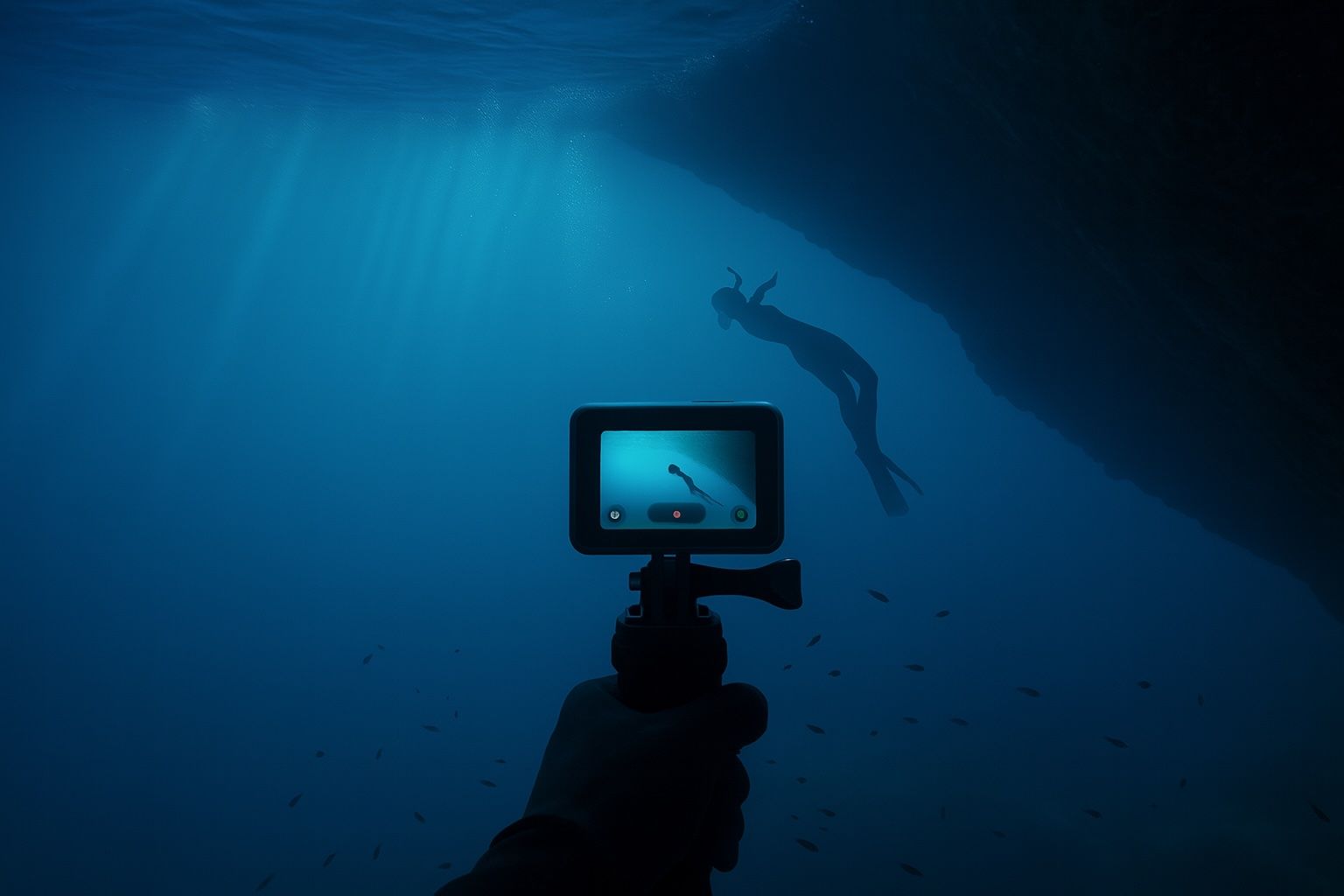- In 1856, William Thompson took the first submerged photo by lowering a box camera into a pool.
- In 1893, Louis Boutan built a crude waterproof housing and captured the first underwater photo while diving.
- Jacques Cousteau’s The Silent World (1956) used specially outfitted underwater cameras.
- The Nikonos V, introduced in 1984, made diving photography affordable and widespread.
- GoPro was founded in 2002, popularizing reef-diving images with its wide-angle waterproof action cams.
- GoPro HERO13 Black, launched in 2024, features 5.3K video, advanced stabilization, and waterproof operation to about 200 ft with an optional case.
- DeepTrekker’s ROV can carry high-end cameras and captures 4K video down to about 1,000 ft underwater.
- Insta360’s X5 Pro Dive (early 2024) is a rugged 360° dive camera offering 8K capture and AI-enhanced video.
- Tidal’s Orca AI-powered multi-camera unit debuted in August 2025, and analyzes fish behavior, lice, and biomass.
- Ace Aquatec expanded its A-Biomass AI camera into new markets in 2024, using AI to measure fish biomass in pens.
Underwater cameras have come a long way since the 1800s. The first submerged photo was taken in 1856, when William Thompson simply lowered a box camera into a pool [1]. In 1893, Louis Boutan built a crude waterproof housing and captured the first underwater photo while diving [2]. Throughout the 20th century, pioneers like Jacques Cousteau used specially outfitted cameras in films (e.g. The Silent World, 1956 [3]), and innovative devices like the Nikonos V (1984) made diving photography affordable and widespread [4]. The digital era and miniaturization kicked off in the 2000s: GoPro’s wide-angle waterproof action cams (founded 2002 [5]) put reef diving images in everyone’s hands, and today’s cameras can shoot ultra-high-definition video with HDR quality. In short, underwater imaging evolved from bulky DIY rigs to sleek systems that capture 8K video and beyond, reflecting over a century of innovation [6] [7].
Types and Categories of Underwater Cameras
Underwater cameras span several categories. Action cameras (like GoPro Hero and DJI Osmo Action) are tiny, rugged units built for motion. They have waterproof casings or even intrinsic waterproofing, and often mount on dive gear or scooters. For example, modern action cams typically have extra layers of water resistance and can be used without an external housing for shallow dives [8]. Compact cameras (point-and-shoot) are small, user-friendly units that usually require a separate underwater housing. They offer better zoom and image quality than action cams, and some models (like SeaLife Micro) even come in their own sealed housing. Interchangeable-lens systems include mirrorless and DSLR cameras in custom housings. These professional rigs (e.g. full-frame Sony/Canon/Nikon bodies in Nauticam or Ikelite housings) deliver superior image quality and control, at the expense of size, complexity, and cost [9] [10]. Finally, ROV/AUV cameras are integrated into underwater drones and submersibles used for exploration, research, aquaculture or industry. Remote-operated vehicles (ROVs) can carry high-end cameras thousands of feet deep – for example, DeepTrekker’s ROV captures 4K video down to ~1,000 ft while the operator remains onshore [11]. (We also see specialty devices like 360° VR cameras for immersive dive footage.) Each category fills a niche: from hobbyist snorkelers to scientists and professional filmmakers.
Applications of Underwater Imaging
Underwater cameras are used in a wide range of fields. Recreational scuba divers and snorkelers love capturing coral reefs, shipwrecks, and wildlife. Professional wildlife filmmakers and photographers use them to document marine species and habitats; landmark series like Blue Planet (2001, 2017) employed cutting-edge underwater rigs to reveal ocean life [12]. In marine science and research, cameras monitor ecosystems, count fish, track migrations, and study climate effects. According to researchers, imaging underwater is vital to discover new species and understand climate change and ocean health [13]. In aquaculture, AI-equipped camera systems (e.g. Tidal’s Orca and Ace Aquatec’s A-Biomass) watch fish cages and even estimate biomass using machine vision [14] [15]. Security and industry also rely on underwater cameras for inspecting ship hulls, bridges, pipelines and ports. And in exploration/archaeology, ROV cameras survey deep sites (like Titanic dives) where humans can’t easily go. Even consumer electronics have dipped toes: waterproof smartphones and housings let hobbyists film backyard pools or beach snorkeling. In all these roles, underwater cameras provide eyes where humans or sunlight cannot reach [16] [17].
Features to Look for in Modern Underwater Cameras
When shopping for an underwater camera, key features ensure success under the waves. First and foremost is waterproof depth rating and housing quality. Ensure the camera or housing can withstand your target depth; for example, housings must seal reliably against pressure. “Look for housings that offer easy access to camera controls, reliable sealing mechanisms, and features like mounts for lights or lenses” [18]. Next is image quality: large sensors, high resolution, and good low-light capability are crucial because underwater scenes can be dark and contrast-poor. Experts advise choosing a model with high megapixels and RAW shooting ability for flexibility [19]. Battery life is also critical – long dives mean no charging station underwater. As one guide notes, “a camera with a long battery life is essential,” and many systems even allow swapping batteries or charging mid-voyage [20]. Other useful features include easy-to-use controls (large buttons and dials that work with gloves, since touchscreens can be hard to use underwater), and durable construction (corrosion-resistant materials, reinforced seals and shockproof bodies [21]). Additional modern perks might include wireless connectivity (for quick topside transfers), GPS dive logging, and onboard stabilization. In summary, a good underwater camera should combine robustness and specialized optics with the flexibility of top-notch imaging technology [22] [23].
Key Manufacturers and Current Product Highlights
Several companies dominate the underwater camera market. SeaLife Cameras makes dedicated dive cameras and lights. For example, the SeaLife Micro 3.0 is a compact all-in-one dive camera with a 16MP Sony sensor and 4K video, leak-proof sealed housing (no O-rings) rated to 200ft [24]. GoPro leads in action cams: the new GoPro HERO13 Black action camera boasts 5.3K video, advanced stabilization, and (with optional case) waterproof operation to ~200ft. Backscatter notes that the HERO13’s “new battery… has massively improved battery life” and it even retains compatibility with older dive housings [25]. DJI (drone maker) offers the Osmo Action series; the latest Osmo Action 5 Pro comes with a 60m (200ft) dive case and features dual color displays and external pressure sensors, making it a strong choice for divers (rated to 60m in its housing) [26]. In more professional tiers, camera manufacturers like Sony, Nikon, Canon supply sensor bodies and lenses; specialized houses such as Nauticam, Ikelite, and Sea & Sea build custom underwater housings for these. (For instance, the Sony A7R IV (61MP full-frame) in a Nauticam housing is a popular pro rig [27].) Olympus/OM System offers the TG‑6 “Tough” compact camera (12MP, 4K, 50ft waterproof without housing) and mirrorless OM‑1 series known for durability. Underwater drone/ROV makers like Blue Robotics (BlueROV2) integrate cameras for industry use. In aquaculture tech, companies like Tidal and Ace Aquatec produce AI-enabled camera systems (Orca, A-Biomass) for fish farm monitoring [28] [29]. These examples illustrate the range: from sea-dedicated companies like SeaLife to mainstream camera brands adapted for diving.
Cutting-Edge Innovations and Technology Trends
Underwater imaging is embracing the latest tech trends. Artificial Intelligence (AI) is increasingly embedded: Tidal’s Orca uses AI analytics to track fish and even feed salmon autonomously [30], and Ace Aquatec’s cameras employ AI to measure fish biomass [31]. Manufacturers are also adding AI-powered image processing to camera hardware: for instance, Insta360’s new X5 360° dive camera uses a “PureVideo” mode that applies neural-network denoising to improve low-light underwater footage [32]. 360-degree capture is another trend: specialized waterproof 360° cameras (like the Insta360 X5) allow immersive VR content from beneath the waves, enabling viewers to look all around a reef scene. Wireless and remote imaging is advancing too. Researchers recently demonstrated a battery-free underwater camera that harvests acoustic energy and uses acoustic backscatter to transmit images – a proof-of-concept that hints at future tetherless systems [33]. Meanwhile, live video transmission via underwater acoustic or optical modems (for inspection ROVs) is under development. Other innovations include hyperspectral and multi-spectral imaging for science: new UHI (Underwater Hyperspectral Imagers) can capture many wavelengths to map seafloors and corals in detail [34]. Improvements in lighting (powerful LED strobes and video lights) continue to reduce the need for extremely high ISO, and wireless dive computer integration now logs camera exposure and GPS for easy dive photo cataloging. In short, AI, 360° imaging, advanced sensors and even novel power/communication methods are pushing underwater cameras into exciting new territory [35] [36].
Recent Developments (2024–2025)
The last two years have seen notable product launches in the underwater camera space. In aquaculture tech, Tidal’s Orca system debuted in Aug 2025: it’s an AI-powered multi-camera unit that monitors fish in net pens, measuring behavior, lice, biomass and more. The company touts features like fish behavior analytics and “higher image quality, better low-light performance, and a wider field of view” to improve fish health assessment [37] [38]. In 2024, Ace Aquatec expanded its AI A-Biomass camera into new markets (Japan, NZ); this system uses underwater video and AI to precisely measure fish biomass in pens [39] [40]. Among consumer products, GoPro released the HERO13 series (2024) with a bigger battery and improved cooling [41]. DJI introduced the Osmo Action 5 Pro dive combo (2023/2024), giving divers a 60m waterproof case and dual screens for composition. Insta360’s new X5 Pro Dive (early 2024) is a rugged 360° camera with 8K capture and AI-enhanced video. Camera-body makers like Nikon and Canon have also updated their systems, which in turn get new housings – for example, Nauticam and Ikelite released housings for the latest mirrorless models. In imaging research, breakthroughs like the battery-free wireless underwater camera (2024, Nature) hint at future directions [42]. Overall, 2024–2025 has seen both professional and hobbyist sectors pushing richer features – from advanced AI cameras for industry to faster action cams for divers.
Expert Insights and Commentary
Industry experts stress that underwater imaging has unique demands. Award-winning underwater photographer Nicolas Remy notes that “underwater photography is like a niche within a niche, with many specific challenges” [43]. He highlights issues like low-light conditions, currents, and the need to get extremely close to subjects. In fact, Remy explains that with traditional DSLRs, composing a shot often means tilting the camera to see the LCD, which “risks bumping against a rock, kicking up sand, or scaring the subject” [44]. This underscores why features like electronic viewfinders (EVFs) and robust autofocus are game-changing underwater. On the industry side, Tidal’s General Manager Anders Fossøy emphasizes the impact of new tech in aquaculture: “We are pleased to be able to support a broader range of operations and to unlock new layers of insight in environments where manual sampling is nearly impossible” [45]. Mount Cook Alpine Salmon’s Jon Bailey, reflecting on Ace Aquatec’s A-Biomass camera, praises its precision: “A-Biomass camera technology has consistently been very precise, with predictions aligning closely to our actual harvest rates” [46]. These comments illustrate how experts see underwater cameras not just as gadgets, but as instruments unlocking data and images that were previously out of reach.
Consumer vs. Professional Equipment
There is a clear divide between consumer-grade and professional underwater rigs. Consumer-level systems (compact cameras, action cams, entry-level mirrorless) are designed for ease and affordability. For example, rugged compacts or micro-four-thirds cameras with affordable housings let hobby divers shoot good images without extensive training. These setups tend to use smaller sensors and simpler optics. In contrast, professional equipment uses high-end bodies and lenses (like full-frame DSLRs/mirrorless) in heavy-duty housings. According to experts, models such as the Nikon D850 or Canon 5D Mark IV (45+ megapixels) are “top choices for the ultimate pro underwater photography” [47]. These pro rigs cost many thousands of dollars (camera + housing + strobes) but deliver exceptional quality and control. In practical terms, a consumer might snap reef photos with a GoPro Hero or Olympus TG-6, whereas a pro shoots a full-frame camera with external strobe lights and exchangeable lenses. However, the lines are blurring as advanced mirrorless models (APS-C or micro-4/3) offer pro-level autofocus and 4K video at moderate prices. Nicolas Remy even suggests that beginners can start with a used micro-four-thirds camera, since underwater requirements (close focus, depth of field) suit smaller sensors – remarking that “the cost of the camera body is irrelevant” underwater compared to housing and lighting costs. In summary, consumer kits trade off ultimate performance for convenience and price, while professional systems maximize image quality and flexibility for specialized uses [48] [49].
Challenges and Future Outlook
Despite progress, underwater imaging remains challenging. Water quickly absorbs light and color, so cameras must cope with blue-green casts and low contrast. Divers often use strobes or filters to compensate. Achieving sharp focus is tough too, as particles and low contrast confuse autofocus systems. Remy points out that even powerful cameras need careful handling: one misstep and you can stir up sand and ruin a shot [50]. Equipment maintenance is another hurdle: every dive risks pressure leaks or corrosion, so rugged build quality is a must. Communication is hard – wireless signals don’t travel in water, so most divers only review images after surfacing (though research on acoustic modems is promising [51]).
Looking ahead, many experts see reason for optimism. AI and autonomy will play a big role: we will see more underwater cameras that identify species or adjust settings on-the-fly. The idea of battery-free or “energy harvesting” cameras could lead to networked sensor grids on reefs or farms [52]. Hyperspectral imaging (for mapping seafloors) and 360° filming will open new scientific and VR experiences [53] [54]. Battery technology and dive computer integration will improve dive time and data logging. As James Cameron and others have shown, technology is letting explorers reach the ocean’s deepest trenches; future innovations might make those deep-sea cameras smaller and more affordable. In short, while factors like light loss, pressure, and costs will always pose challenges, the future of underwater imaging looks bright. We can expect steadily smarter cameras and accessories that will make capturing the hidden underwater world easier and more insightful than ever.
Sources: Historical and technical details were compiled from expert articles and industry reports [55] [56] [57], recent news and company announcements [58] [59], and interviews with professional underwater photographers [60] [61]. These sources ensure an up-to-date and comprehensive view of underwater camera technology.
References
1. www.scubadiving.com, 2. www.scubadiving.com, 3. www.scubadiving.com, 4. www.scubadiving.com, 5. www.scubadiving.com, 6. www.scubadiving.com, 7. www.scubadiving.com, 8. www.deeptrekker.com, 9. www.uwphotographyguide.com, 10. www.deeptrekker.com, 11. www.deeptrekker.com, 12. www.scubadiving.com, 13. www.nature.com, 14. www.seafoodsource.com, 15. www.seafoodsource.com, 16. www.nature.com, 17. www.scubadiving.com, 18. eagleraydiving.com, 19. eagleraydiving.com, 20. eagleraydiving.com, 21. eagleraydiving.com, 22. eagleraydiving.com, 23. eagleraydiving.com, 24. www.sealife-cameras.com, 25. www.backscatter.com, 26. www.divers-supply.com, 27. www.uwphotographyguide.com, 28. www.seafoodsource.com, 29. www.seafoodsource.com, 30. www.seafoodsource.com, 31. www.seafoodsource.com, 32. www.insta360.com, 33. www.nature.com, 34. www.mdpi.com, 35. www.insta360.com, 36. www.nature.com, 37. www.seafoodsource.com, 38. www.seafoodsource.com, 39. www.seafoodsource.com, 40. www.seafoodsource.com, 41. www.backscatter.com, 42. www.nature.com, 43. www.dpreview.com, 44. www.dpreview.com, 45. www.seafoodsource.com, 46. www.seafoodsource.com, 47. www.uwphotographyguide.com, 48. www.uwphotographyguide.com, 49. www.dpreview.com, 50. www.dpreview.com, 51. www.nature.com, 52. www.nature.com, 53. www.mdpi.com, 54. www.insta360.com, 55. www.scubadiving.com, 56. eagleraydiving.com, 57. eagleraydiving.com, 58. www.seafoodsource.com, 59. www.backscatter.com, 60. www.dpreview.com, 61. www.seafoodsource.com










